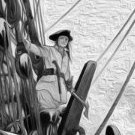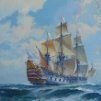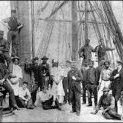Check out our new MSW Sponsor Innocraftsman
×
-
Posts
1,145 -
Joined
-
Last visited
Reputation Activity
-
 Keith_W got a reaction from Esap in Furled , unfurled or no sails -Preference
Keith_W got a reaction from Esap in Furled , unfurled or no sails -Preference
Arguing that you should leave off the sails because it might hide your rigging is the same as arguing that you should leave off the top deck because of all the effort you put into detailing the second deck. If you like the look of sails, then go for it. I personally like sails ... IMO the ship looks incomplete without it. No car modeller would make a model of a car without tyres. I don't know why ship modellers keep making models of ships without sails.
-
 Keith_W got a reaction from Jeff59 in Bismarck by madtatt - FINISHED – Trumpeter with Pontos set – 1:200 - PLASTIC
Keith_W got a reaction from Jeff59 in Bismarck by madtatt - FINISHED – Trumpeter with Pontos set – 1:200 - PLASTIC
If you ever enter a model competition and don't win a prize for this, then there is no justice in this world. This is THE most amazing model of the Bismarck I have ever seen, and I have seen quite a few! Well, maybe the one in the Munich museum is better, but this one comes very close.
-
 Keith_W got a reaction from miloman in Bounty Launch by KeithW - FINISHED - Model Shipways - SMALL - kitbashed
Keith_W got a reaction from miloman in Bounty Launch by KeithW - FINISHED - Model Shipways - SMALL - kitbashed
Small update for those following.
The hull is now almost complete. I mounted the thwarts and chose the angle of the masts today. This is how I did it:
The most horizontal part of the ship is the middle floor plank, so I put a spirit level there and adjusted the height of the stand until it was level.
I was then able to align the masts, using the door frame (not in the picture) as my vertical reference.
I mounted the rudder with the pintles and gudgeons. I know of the problems others have been having with it (Meredith burnt a cake because she found it exceptionally fiddly), but I had no problems. It might be because my kit includes different pintles and gudgeons ... other build logs mention having to fabricate it out of brass strip. Not so here, mine came pre-bent and pre-drilled. However, the pre-drilled holes were a little off so I ended up fabricating my own anyway.
For trouble-free mounting, try what I did - mount the gudgeons to the rudder and the keel. Make sure they are aligned properly. Then mount the pintles onto the gudgeons, then slide the rudder into place. Once in place, pin the pintles securely.
These are the shrouds I made using my really poor soldering skills. At least I didn't blacken the deadeyes by burning them!
This is how I align the deadeyes prior to rigging. Pin the deadeye to the hull, then thread some rope through the deadeye. Pull the rope tight against the point where the shroud attaches to the mast, then CA the deadeye in place.
Ready to begin standing rigging tomorrow.
-
 Keith_W got a reaction from Javelin in HMS Royal William by KeithW - Euromodel - 1/72
Keith_W got a reaction from Javelin in HMS Royal William by KeithW - Euromodel - 1/72
My order for rope from Chuck at Syren arrived faster than expected - 12 days instead of the anticipated 20 days. This means I can get back to work on what I dread the most - rigging.
I would like to thank @BANYAN for lending me his rope server. I was originally going to serve my rope with tan string, but he convinced me to use black. He also pointed out that some lines were served along their entire length, e.g. the first line in the shroud, to prevent chafing. I had forgotten this. I have VERY FINE black string, and even with the machine it took forever to serve 56 lengths of rope for the shrouds. This is his machine:
Notice there are two motors - one to turn the rope, the other to advance the feed. It is possible to set the machine up, leave it running, go make a coffee, etc. and return to have your rope all nicely served. I forgot to ask if it had an auto-off feature, because I was not game to leave it running unattended. It's not my machine! So I sat there and manually served all the rope. It took a really long time. On the plus side, I covered a lot of podcasts.
All the rope has been served and tagged sequentially so I don't lose track of which is which.
The served rope neatly stacked. The fid was made by cutting off the bottom of the topmast and topgallant mast, cutting a square hole using the table saw as a dado cutter, and gluing the bottom back on. Once securely glued on, a hole was drilled from the bottom, through the fid, and the whole thing was pinned together. It was sanded flat and painted, and you can not see that it has been cut. I know that the crows nest should be painted all black, but I like the contrast of the pearwood to black so I left it that way.
I have also constructed a base out of plywood and veneered it with maple burl. The reason I did not use the Euromodel base is because I need to route power into the ship through the supports. You may recall from my earlier posts that very early in the build, I drilled a hole into the keel, placed a nut there, and soldered wire to the nut to run power to the whole ship. The whole thing was reinforced with spare plywood. This was always the plan.
You can see the support I made for the ship in the second photo. This is 3mm brass rod, bent to shape with the help of my vice. It was then soldered with reinforcements. It is then screwed through the base into the hull with an extra thick stainless steel bolt, and I made the base extra wide. The base is also ballasted for even more stability. It is really solid and stable and I doubt it would tip over in the car even if I took a fast corner.
I can tell you that applying burl veneer is not easy! When you receive it, burl is always badly warped thanks to the grain of wood running in different directions, and there are holes everywhere. The first step is to flatten the veneer - spray it with water, then sandwich it between two melamine boards. After 24 hours, it is dry and must be used within a few hours otherwise it will curl up again (don't ask me how I know). Then brush on some PVA thinned with water (70/30) on both the veneer and the substrate (the plywood frame), and sandwich between the boards again. Wait 24 hours. Then trim and apply the edge veneers, trying to match the grain as best as you can. Clamp and wait 24 hours per side. Then it's clean up time - patch all the holes with spare veneer, trying to achieve a colour match. Make up some filler by mixing sawdust with thinned PVA. Sand the whole thing flat, going down the grits to 600. Then I applied Tung oil. So far 6 coats. I am waiting for the last coat to dry before I seal it with wipe-on poly. It is almost 2 weeks and the Tung oil still feels a little bit oily.
If you look closely, you can see that I applied the top veneer before the edges. In hindsight, I can recommend that you do not do this, because you can see the side of the edge veneer. I should have applied the edge veneer first, and then the top veneer so that it overhangs the edge.
Removing the name plate reveals a hidden compartment with the battery and a switch.
After going through all that rope, I found that I did not order enough. Another order was fired off to Chuck, hopefully this will be enough rope to finish the project. And I am woefully short of deadeyes, Euromodel did not supply anywhere near enough of the 3mm deadeyes. I have put together a shopping list and will visit my hobby shop later this week.
-
 Keith_W got a reaction from Yann Kermeur in HMS Bounty Jolly Boat by SighingDutchman (Seb) – FINISHED - Artesania Latina – 1:25
Keith_W got a reaction from Yann Kermeur in HMS Bounty Jolly Boat by SighingDutchman (Seb) – FINISHED - Artesania Latina – 1:25
Re: oarlocks. Take a look at @chris watton's ships boats of various types. I hope he doesn't mind me posting this photo:
You can see that different oar locks were in use.
This is from AOTS: Bounty
The illustration depicts the "same" 23 foot launch used by Bligh. Note the square cutouts.
Now take a look at the instructions for Model Shipways Bounty Launch. If you click on "Instructions and Parts List" you will be able to download the instructions. This gives you a very good look at their opinion of what the oarlocks should look like.
In reality, ships boats were not standardized, and often changed during the course of duty of the ship. They came from different contractors. Bligh's Launch has not been preserved - if you recall, he sailed to Java and boarded a Dutch ship that took him back to England. Nobody knows what happened to the Launch after that. So in my opinion, do what you like and what you find aesthetically pleasing. Any of the choices you listed are historically plausible, and there is no evidence to suggest one way is more accurate than another. Just don't paint it pink and put Barbie and Ken in it.
-
 Keith_W got a reaction from Bill Morrison in HMS Diana 1794 by newbee - Caldercraft - 1/64
Keith_W got a reaction from Bill Morrison in HMS Diana 1794 by newbee - Caldercraft - 1/64
Without knowing the model and being able to see where the frames should be, it is difficult to know if this was a builder's error (e.g. cut the grating holes in the wrong position), or whether the manufacturer positioned the frames wrongly. Either way, you need to glue a beam under the broken deck to support it. This is what I would do:
- cut the widest beam you think will fit through the hole
- drill a hole through one end of the beam and tie some string to it IN CASE you drop it and need to fish it out.
- push the beam through the grating hole and try to rotate it to fit. If it does not fit, trim it and try again.
- when you get it to fit, apply glue and attach it to position, then cut off the string. Don't worry about the excess string that you can't reach, it will be inside the hull and it won't be seen.
-
 Keith_W got a reaction from Bill Morrison in HMS Diana 1794 by newbee - Caldercraft - 1/64
Keith_W got a reaction from Bill Morrison in HMS Diana 1794 by newbee - Caldercraft - 1/64
Oh boy. That is a really sad looking ship. To think that someone lavished so much time and love on it, and then it languished in storage until it looks like that. A lot of building mistakes also. Good luck restoring it!
-
 Keith_W got a reaction from Mr Whippy in Artesania Latina HMS Bounty questions
Keith_W got a reaction from Mr Whippy in Artesania Latina HMS Bounty questions
Hi Ted, thanks for visiting my log, although it's more of a list of things you shouldn't do! I can't answer most of your questions, except to point you towards AOTS: Bounty by Mackay, as others have done. To be honest, when I built this ship all those years ago, all I wanted was a nice looking boat as a centerpiece for my living room. I didn't really care about historic accuracy, I just wanted a nice looking boat.
As for deck planking patterns, take a look at Ulisses Victoria's article in the MSW database: http://modelshipworldforum.com/resources/Framing_and_Planking/Deck_PlankingIIbuttshifts.pdf
-
 Keith_W got a reaction from Scottish Guy in Cutty Sark by Richard Dunn - 1/40 scale - scratch built semi-kit prototype
Keith_W got a reaction from Scottish Guy in Cutty Sark by Richard Dunn - 1/40 scale - scratch built semi-kit prototype
It will be almost impossible to fabricate a moulding out of wood. The grain will be running in different directions, and it would be incredibly fragile.
This is what I did when I had to fabricate my own windows:
I used a milling machine (Proxxon MF70) to mill a channel in a block of wood, then my Byrnes table saw to take off slices. The moulding was made with strip styrene glued to the curved edge, and the whole thing was painted.
If you really want to make the moulding out of wood, you will need to carve it out with a suitable router bit that you may have to fabricate yourself. It will need to be supported by thick wood to stop it from breaking off. I would suggest a Proxxon MF70 with the CNC option but that is a lot of money to invest in only one part.
-
 Keith_W got a reaction from Scottish Guy in Cutty Sark by Richard Dunn - 1/40 scale - scratch built semi-kit prototype
Keith_W got a reaction from Scottish Guy in Cutty Sark by Richard Dunn - 1/40 scale - scratch built semi-kit prototype
Your house must be massive for you to have something like that lying around somewhere and forgetting that you had it I have a typical Melbourne home ... expensive and small. I would definitely notice something like that in my house!
-
 Keith_W got a reaction from Scottish Guy in Cutty Sark by Richard Dunn - 1/40 scale - scratch built semi-kit prototype
Keith_W got a reaction from Scottish Guy in Cutty Sark by Richard Dunn - 1/40 scale - scratch built semi-kit prototype
Not at all, Richard. Most people on this site are concerned about accuracy. I think you will see that on any modeller's forum, e.g. I have seen discussions on tank and plane kits which were criticized for being inaccurate. If you look over the build logs, particularly by some of the more ambitious modellers, a lot of effort goes into research and correcting kit deficiencies. And don't forget that MSW is part of the Nautical Research Guild, whose mission is ... nautical research. So any feedback you provide about inaccuracy of texts and kits is welcome. In fact, more than welcome ... I for one would LOVE to see it. It would be a very valuable resource for anybody who wants to build a Cutty Sark. This is why I suggested you sell plans or discuss developing a kit with a manufacturer. It would be the ONLY kit I am aware of which has measurements laser scanned from the actual ship.
If trolls were to attack you for anything true that you have said, I am sure many members would defend you. Not to mention the mods.
-
 Keith_W got a reaction from Scottish Guy in Cutty Sark by Richard Dunn - 1/40 scale - scratch built semi-kit prototype
Keith_W got a reaction from Scottish Guy in Cutty Sark by Richard Dunn - 1/40 scale - scratch built semi-kit prototype
Pretty amazing that you are doing this. 1/40 is a bit too large for me, I do not have anywhere in the house that would fit such a model. I would be really interested in seeing progress pics of the model as she evolves, though. If you wish to monetize your work, perhaps you could discuss selling your plans to a model kit manufacturer. Since your files are digital, it should not be too difficult to offer the kit at a more "reasonable" scale, say 1/72.
-
 Keith_W got a reaction from Javlin in Impressive non-ship models (link)
Keith_W got a reaction from Javlin in Impressive non-ship models (link)
This Mil Mi-24 helicopter is equally impressive. It is offered for 18,000 Euros from Helicrazy: http://www.helicrazy.com/crbst_86.html
That's right, you can buy a BMW with that kind of money. It is powered by a jet turbine engine. For those who don't know, real helicopters are not powered by piston engines because they generate too much vibration. Instead, a jet engine blows into a turbine, which spins the crankshaft and thus the rotor via a transmission. Most nitro powered helis use 2 stroke piston engines because of the sheer cost of manufacturing a scale miniature of a jet turbine. But if you want realism, a jet turbine is the only way.
Need to be convinced? Watch this video:
-
 Keith_W got a reaction from GrandpaPhil in Impressive non-ship models (link)
Keith_W got a reaction from GrandpaPhil in Impressive non-ship models (link)
Want to be impressed? Want to be really impressed? Well, head over here: http://slightlywarped.com/detailed-close-ups-of-star-wars-spaceships/
You will see what professional model makers can do. They MUST make their models look realistic, because it's going to appear on film!
Here is a sample.
-
 Keith_W got a reaction from GrandpaPhil in Impressive non-ship models (link)
Keith_W got a reaction from GrandpaPhil in Impressive non-ship models (link)
This Mil Mi-24 helicopter is equally impressive. It is offered for 18,000 Euros from Helicrazy: http://www.helicrazy.com/crbst_86.html
That's right, you can buy a BMW with that kind of money. It is powered by a jet turbine engine. For those who don't know, real helicopters are not powered by piston engines because they generate too much vibration. Instead, a jet engine blows into a turbine, which spins the crankshaft and thus the rotor via a transmission. Most nitro powered helis use 2 stroke piston engines because of the sheer cost of manufacturing a scale miniature of a jet turbine. But if you want realism, a jet turbine is the only way.
Need to be convinced? Watch this video:
-
 Keith_W got a reaction from GrandpaPhil in Impressive non-ship models (link)
Keith_W got a reaction from GrandpaPhil in Impressive non-ship models (link)
OK I know this is a ship model forum but surely most of us can appreciate other models as well
I thought I would post a link to this site: http://www.armortek.co.uk/index.html
Armortek makes 1/6 scale model tanks, fabricated from metal. Unfortunately, their production goes in runs, so once a kit is out of production, it is out of production. They are currently selling a British Mk. IV WW1 tank. Very impressive, but not as impressive as this:
... a 1/6 scale King Tiger, measuring 1.2m long and weighing 60kg. Here is a video of it in action. Note the realistic engine sound (which is computer controlled and responds to revs):
-
 Keith_W got a reaction from Bill Morrison in Revenge 1577 by Loracs - Amati - 1:64
Keith_W got a reaction from Bill Morrison in Revenge 1577 by Loracs - Amati - 1:64
Of course nobody is offended ... your model, your choice!
-
 Keith_W got a reaction from Bill Morrison in HMS Royal William by KeithW - Euromodel - 1/72
Keith_W got a reaction from Bill Morrison in HMS Royal William by KeithW - Euromodel - 1/72
Here are a couple more minor kit issues.
The middle gun deck is supplied pre-cut with a rounded bow section. However, as you can see, the rounded bow section will clash with the front bow filler block. The solution is to simply cut the deck and discard the piece.
The keel describes a sloppy fit with the false keel. After checking with the plans, and confirming that the top of the keel is supposed to rise to the level of the main deck (if the bowsprit wasn't in the way), I shaved away the area painted in red. I now have a perfectly fitting keel.
The kit doesn't include a mizzenmast support, so I fabricated one and installed it.
My wife returned from a day of shopping to find that I had turned nearly every spare inch of floor space into reading space for Royal William plans! She was not very impressed, especially since I had not kept the modelling door closed and the dust was in the main living area. I had to put a stop to my modelling and vacuum the house.
-
 Keith_W got a reaction from Bill Morrison in HMS Royal William by KeithW - Euromodel - 1/72
Keith_W got a reaction from Bill Morrison in HMS Royal William by KeithW - Euromodel - 1/72
As of tonight, the hull is almost complete and will be ready for planking in a couple of days. I still need to shape the stern and bow fillers and bevel the bulkheads.
I installed additional reinforcements for the top deck bulkheads. The frame is now incredibly rigid.
I thought I would draw attention to a problem with bulkhead "F". I am not sure if other RW builders encountered the same problem as me - none of them have mentioned it at least. Note that bulkheads E and F are correctly installed with respect to the false keel. Also, the stringers for the main and middle deck run straight and true - they are so perfectly aligned that they simply fell in! Yet, bulkhead F has a pronounced 1mm step at the level of the fo'c'sle deck, AND the lower deck stringer is bent downwards.
The exact same problem is present on the other side, so it's not as if I installed bulkhead "F" at an angle. Did any of you have this problem?
-
 Keith_W got a reaction from Bill Morrison in HMS Royal William by KeithW - Euromodel - 1/72
Keith_W got a reaction from Bill Morrison in HMS Royal William by KeithW - Euromodel - 1/72
Yes Brian, it would appear that there are some differences between your kit and mine.
By the way, I joined a local woodworker's club (here's a shout out to Waverley Woodworkers Club) so that I can have access to their tools ... and what a collection they have! The WWC is more set up for people who work with larger scale projects, so all their equipment is full size. Their lathe is large enough to turn bowls, for example. Otherwise, they have every piece of equipment that we would need - drill press, disc sander, drum sander, belt sander, router, lathes, mills, grinders, polishers, jig saws, band saws, etc. They will save me a fortune on tools, but I would still benefit from miniaturized versions of the above for our hobby.
Anyway, I did more work on the boat today.
The first thing I did was to lay out all the frames against the plans. In particular, I was looking for the incorrectly labelled bulkheads E and F as noted by VinceP in his build log. Sure enough, as he described, on Plan Sheet 4 the drawing shows correct placement of the bulkheads, but the labels for E and F are the wrong way round. Importantly, the bulkheads themselves are correctly labelled.
As noted elsewhere, the RW bulkheads are named according to ship builders convention, as follows:
(STERN) 8 - 7 - 6 - 5 - 4 - 3 - 2 - 1 - 0 - A - B - C - D - E - F (BOW)
The next thing is to drill the holes in the false keel for future attachment of a stand. The drill press at the WWC came in handy. I drilled a 6mm diameter hole in the 10mm width false keel - only 2mm of clearance either side! The precision of the drill press ensured that my hole was perfectly centered. The above pictures show me milling a hole to accept the nut. Not pictured are the cheeks that I made to strengthen the weakened keel and to hold the nut in.
Start of bulkhead attachment. The bulkheads were attached with the aid of a square to ensure ... squareness. As noted elsewhere, the bulkheads are a rather sloppy fit and need to be shimmed.
All the bulkheads have now been fitted. Alignment was checked visually and with the aid of a stringer (not shown).
Additional reinforcements were made to ensure hull rigidity. These were made from scrap wood - there is more than enough left over to make these parts!
At this point, I chose to install the lower gun deck. This deck has notches for the bulkheads pre-cut, so it made sense to install it to help check alignment. Note that the deck is supplied in left and right halves, but installation is impossible unless it is also cut across the beam (into quarters).
-
 Keith_W got a reaction from Bill Morrison in HMS Royal William by KeithW - Euromodel - 1/72
Keith_W got a reaction from Bill Morrison in HMS Royal William by KeithW - Euromodel - 1/72
My kit room has been tidied and prepared for the new build. It won't look as neat as this for another three years. Let's go!!!
The room has been re-arranged with the power tool bench behind me, and the main modelling table in front of me. All I need to do is turn around to have access to power tools. The desk by the window is where I will do all the Dremelling. Not pictured is my new shelving unit where all my tools, paints, and glues are neatly stowed away. Also not pictured is the clipboard where the plans will be displayed.
The main modelling table with the modelling lamp. You can also see my handheld vacuum which is vital for keeping the peace in the household.
The tool bench, from (L-R): Sherline 4410 Lathe, Byrnes Disc Sander, Proxxon MF70 mill.
-
 Keith_W got a reaction from Bill Morrison in HMS Royal William by KeithW - Euromodel - 1/72
Keith_W got a reaction from Bill Morrison in HMS Royal William by KeithW - Euromodel - 1/72
INDEX OF PLANS
Sheet 1: Overview of ship
Sheet 2: Masts and Yards
Sheet 3: Decorations
Sheets 4, 5, 6, 7: General construction details
Sheet 8: Longitudinal and Cross section (for scratch builders)
Sheets 9, 10: Deck furniture
Sheets 11, 12: Standing rigging
Sheets 13, 14, 15: Running rigging
Sheet 16: Mast and yard details
Sheet 17: Ships plan
-
 Keith_W got a reaction from Bill Morrison in HMS Royal William by KeithW - Euromodel - 1/72
Keith_W got a reaction from Bill Morrison in HMS Royal William by KeithW - Euromodel - 1/72
OVERVIEW AND GENERAL KIT IMPRESSIONS
The box is really large and heavy, and arrives absolutely packed. Every bit of spare space is taken up by ... peanut foam. I filled up a plastic bag full of these annoying things and was able to get at the kit.
First, the bad:
The instructions are not very good (to say the least). For a kit of this complexity, the rather thin instruction booklet only contains THREE pages of instructions, of which the first page is taken up by the history of the ship, and some congratulatory notes. This shot is of the second page, and contains nothing that no experienced modeller wouldn't know. OTOH the plans (see next post) are excellent, however many diagrams in the plans could have been printed on smaller pieces of paper and bound in a booklet instead. As it is, all 17 sheets of plans are too large, unwieldy, and hard to find - which is why I took the trouble of making an index for myself (and for others who may follow).
The ships boat is a cast resin item. Whilst it is well cast, other kit manufacturers are offering plank-on-frame boats. Oh yes, only one boat? For a first rate ship?
Some of the castings are not very good. Look at how chunky this window is. This will have to go into the bin - I can only hope my skills are up to making a replacement from scratch.
Likewise, the ship's lantern is a clumsy looking affair.
These are meant to be gunport hinges.
And these are meant to be gun carriages!
The flags are printed on cloth. I am a little indifferent to the quality of the printing.
However, the wood is of decent quality. On some older RW kits, the masts are pre-tapered. On this brand new RW kit, fresh from Italy, the masts are not. No matter, I have a lathe!
The bulkheads are unbelievably thick and sturdy - 10mm thick!
Some other castings, like the figurehead, are excellent.
And so are the castings for the stern decorations.
... and the side decorations.
The blocks are probably the best I have ever seen included in a model kit. Unfortunately, they are all mixed up in a bag. I will have to carefully sort them and put them away.
-
 Keith_W got a reaction from hollowneck in Shore Leave forum is on temporary hiatus until further notice.
Keith_W got a reaction from hollowneck in Shore Leave forum is on temporary hiatus until further notice.
I would suggest that rather than pruning those threads, just close them with the reason being: "too many posts in this thread were infringing copyright, and it would take too long for admin/mods to go through the thread and delete them. 150,000 posts in total across multiple threads. Please refrain from posting copyrighted images in the future".
It would save you a lot of time and take the tediousness out of it.
Speaking of tedious ... back to rigging for me.
-
 Keith_W got a reaction from Ian_Grant in Cutty Sark by Richard Dunn - 1/40 scale - scratch built semi-kit prototype
Keith_W got a reaction from Ian_Grant in Cutty Sark by Richard Dunn - 1/40 scale - scratch built semi-kit prototype
Your house must be massive for you to have something like that lying around somewhere and forgetting that you had it I have a typical Melbourne home ... expensive and small. I would definitely notice something like that in my house!








.jpg.d84ec4dad1d7791e855dca06210ab6f3.thumb.jpg.f45209242e851d4409eca1a09293165b.jpg)
